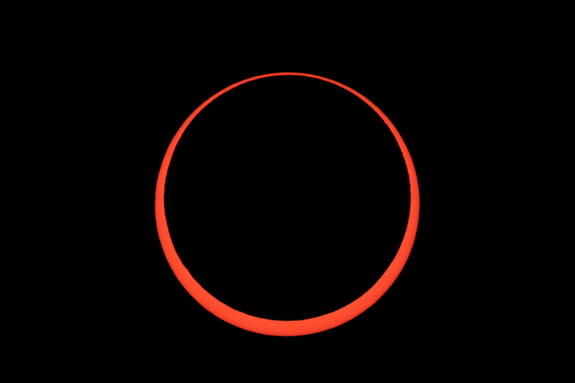'Ring of Fire' Solar Eclipse: The Science of Today's Strange Celestial Event
Update: See the first photos of the solar eclipse here. An initial video of the 'ring of fire' eclipse is here.
A potentially dazzling ring-shaped solar eclipse today (May 9) will be a celestial show sure to amaze for those able to view it. Weather permitting, the passage of the moon in front of the sun will make the star look like a cosmic "ring of fire" for observers in western Australia, where the best viewing areas are.
As astounding as the show might be, however, some keen observers will have more than just beauty in mind when they're looking skyward. Scientists on the ground can make important observations during today's ring-shaped annular solar eclipse, which could lead to a more comprehensive understanding of the sun.
One of the scientists ready for today's eclipse is Jay Pasachoff, a veteran eclipse chaser and astronomer at Williams College in Massachusetts. Pasachoff has traveled to Australia to collect data and witness his 56th solar eclipse. While the solar eclipse is occuring today (May 9), the local time in western Australia where views are at their best will be Friday, May 10, local time. [See Amazing Photos of a 'Ring of Fire' Solar Eclipse ]
Skywatchers in certain parts of Australia and the islands of the Southern Pacific Ocean will be able to view the eclipse in person. If you don't happen to live in one of those areas, you can watch the solar eclipse live on SPACE.com, courtesy of the online Slooh Space Camera, beginning at 5:30 p.m. EDT (2130 GMT).
"At an annular eclipse we're really studying the active regions of the sun, which are the sunspots," Pasachoff who also chairs the International Astronomical Union's working group on eclipses told SPACE.com.
Satellites in orbit could observe solar activity during the eclipse as well, Pasachoff said. When combined and compared with data collected on the ground, the information gathered by the spacecraft will give researchers a larger picture of what the sun is doing during its expected peak in activity — or "solar maximum" — this year.
"So we're just doing the best we can to show what's going on on the ground and to give the highest resolution observations of what's going on, on the ground and the sunspots at the same time," Pasachoff added.
During the solar eclipse, the moon will cover about 95 percent of the sun when it passes in front of the star's face, leaving Earth in the moon's shadow. The sky will not be noticeably darker, however. Special eyewear, camera and telescope filters and other means of protection are still necessary to observe this kind of eclipse safely in person.
Parts of the Hawaiian Islands, the southern Philippines, eastern Indonesia, other parts of Australia, small areas of Papua New Guinea and a tiny part of New Zealand (weather permitting) could see a partial view of the eclipse.
Today's eclipse follows a partial lunar eclipse that shadowed the moon above Central Asia, Western Australia, Eastern Europe and Africa. Another minor lunar eclipse will occur on May 24.
This isn't the only solar eclipse of the year. On Nov. 3, a rare annular eclipse that transitions into a total eclipse — called a hybrid eclipse — will be visible in the northern Atlantic Ocean and into equatorial Africa.
WARNING: Never look directly at the sun during an eclipse with a telescope or your unaided eye. Severe eye damage can result and scientists use special filters to safely view the sun.
Editor's note: If you live in the observing area of today's solar eclipse and safely snap an amazing picture of the sun that you'd like to share for a possible story or image gallery, send photos, comments and your name and location to Managing Editor Tariq Malik at spacephotos@space.com.
Follow Miriam Kramer on Twitter and Google+. Follow us on Twitter, Facebook and Google+. Original article on SPACE.com.
Copyright 2013 SPACE.com, a TechMediaNetwork company. All rights reserved. This material may not be published, broadcast, rewritten or redistributed.



